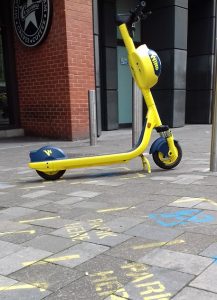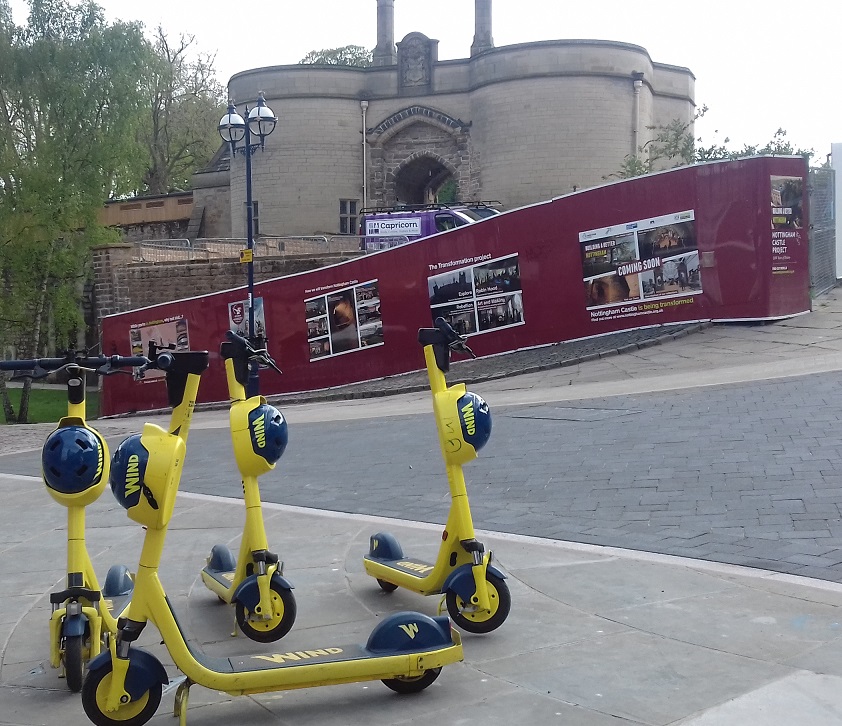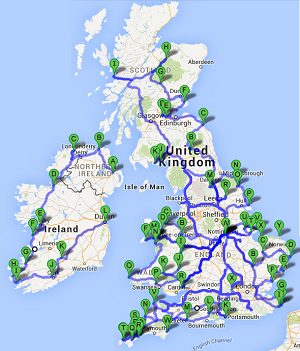Ride like the Wind, Bullseye!
I take a particular interest in transport technologies, particularly watching and reporting on electric power becoming an everyday reality, and so took the opportunity to try out the e-scooters currently for hire in Nottingham.
The Wind e-scooter project is a year-long trial running from October 2020, to establish whether these machines might improve urban mobility and reduce congestion. It’s one of a number of similar trials in other English locations from Yeovil to York, Great Yarmouth to Whitehaven. According to industry magazine Zag, the Nottingham trial is the most popular of all of these.

Scooter use is based on a smartphone app, which first has to verify identity and payment via a bank or Paypal account. This should be straightforward, but my experience was a bit of a palaver. The app didn’t recognise my old-style (perfectly legal) UK driving licence. Direct email support rectified this, but only after a number of back-and-forth exchanges to Wind’s office in Germany to establish precisely what the problem was. I can see that they need to check these details but this seems like an area for improvement.
With the app installed, the phone’s GPS is used to locate the nearest available scooter. This worked really well – when there was one available. The machine is quickly unlocked via the app, and the onboard helmet can also be released. I never saw anybody actually using the helmet, and I didn’t either. Even without the current plague, the idea of headgear that has been used by an unknown number of other people isn’t very appealing. Mind you, neither is the thought of a head injury should the ride go a bit pear-shaped.
I had three destinations to visit that day – one retail collection, a visit to a friend, and an appointment at the castle – currently closed for refurbishment but I had to catch up on a heritage project I’m involved with there. The e-scooter seemed an ideal way to get from one place to another with minimum effort and in the quickest time.
It didn’t take long to find an available machine, and I was grateful that I’d earlier seen another rider set off. First time users like me might be baffled by the starting procedure, which isn’t well explained. Take the machine off its stand and, with one foot on the platform and a thumb on the throttle lever (not a motorcycle-type twistgrip), push off with the other leg. Failure to give it this bump start means going nowhere.
It’s simple enough once understood, and the device responded well. The first couple of metres might have been a little wobbly as I found the balance of gravity and power, but it’s really very easy after this.

Less enjoyable was mixing it with live traffic on the roads. The Wind electric scooters are supposed to be used on roads only, not pavements, which presents obvious challenges. Not least of these is the condition of road surfaces, as potholes and small wheels make poor companions. Where cycle lanes are available they provide the best option, but like many British cities the network in Nottingham is patchy at best.
This is particularly frustrating where areas have been pedestrianised. To get from one end of a pedestrianised street to the other means either going around three sides of a square or simply riding the scooter through the foot traffic.
Is this legal? Absolutely not, but it is widely done. At one point, partly as a test, I rode onto a pedestrianised street in full view of a couple of community support officers. Not an eyelid was batted, and certainly no pedestrians seemed bothered by my gentle progress.
Where the system fell down for me was in finding a scooter when I wanted one. After my meeting I was a mile or two from my final rendezvous, and a bit short of time, so hoped I could take a final ride. Sadly no machines were available anywhere on my route, except one with a dead battery.
Availability is going to be an issue if these things become permanent fixtures in our urban areas. There will inevitably be a tidal flow of scooters at certain times of day, leading to surpluses in some places and shortages in others.
Having said that, they certainly provide an interesting additional form of urban mobility. The Nottingham project seems largely focused on commuter traffic, which is fine for riders living within the geofenced area around the city. Scoot-commuting might be appealing in fair weather but I can’t imagine many takers in winter.
Costs seem reasonable too. Wind e-scooter hire is 12p per minute, with no unlock charge (some, like the Voi trial in Bristol, sting the user for £1 before they’ve gone a single metre). Long-term hire seems a bargain at just £30 per month for those living within the zone.
I’ll certainly be using the Wind e-scooters again, and hope they move from being a trial to a permanent feature.




